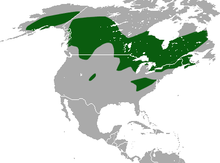American pygmy shrew
The American pygmy shrew (Sorex hoyi) is a type of shrew. It found in Northern Alaska, Canada, and the northern and southern United States.[4]
| American pygmy shrew[1] | |
|---|---|
| Scientific classification | |
| Domain: | Eukaryota |
| Kingdom: | Animalia |
| Phylum: | Chordata |
| Class: | Mammalia |
| Order: | Eulipotyphla |
| Family: | Soricidae |
| Genus: | Sorex |
| Species: | S. hoyi
|
| Binomial name | |
| Sorex hoyi | |

| |
| American pygmy shrew range | |
It is found in northern coniferous and deciduous forests of North America. It is believed to be the second-smallest mammal in the world. Because of its fast metabolism, it is always eating.
Description
changeThe American pygmy shrew is the smallest mammal native to North America. Its is about 5 cm (2 in) long. It weighs about 2.0 to 4.5 g (0.07 to 0.16 oz).[5] Its fur is reddish or grayish brown during the summer. It is white-gray during the winter. It molts about two times a year.[6] It has a narrow head with a pointed nose, and whiskers. The eyes are small.[7]
Distribution
changeThey are found from Northern Alaska, to the Rocky Mountains. They are also found from the Great Lakes region, to the Appalachians, to the eastern side of Canada.[4][7] Even though the American pygmy shrew prefers wet habitats, it has been seen in places with both wet and dry soil.[6]
Feeding
changeIt mainly eats insects and insect larvae, and worms. To stay alive, the American pygmy shrew has to eat every 15 to 30 minutes, day and night.[8]
Predators
changePredators of the American pygmy shrew include hawks, brook trout, owls, snakes, and domestic cats.
Reproduction
changeLittle is known about the reproduction of American pygmy shrews. They appear to mate all year round.[9] The gestation period is estimated to be 18 days.[7] Females give birth to three to eight young ones. They usually leave the family at the age of 25 days. The maximum lifespan of an American pygmy shrew is believed to be about 16–17 months.[9]
Behavior
changePygmy shrews dig through soil to look for food. They can use tunnel made by other animals to help them look for food.[10] They do not sleep or rest for a long time. They have great senses of smell and hearing to help them find their food.[7]
References
change- ↑ Hutterer, Rainer (2005). Don E. Wilson; DeeAnn M. Reeder (eds.). Mammal Species of the World (3rd ed.). Johns Hopkins University Press. p. 289. ISBN 978-0-8018-8221-0.
- ↑ Dirrigl Jr., F. & Hammerson, G. (2008). "Sorex hoyi". IUCN Red List of Threatened Species. 2008. Retrieved 8 February 2010.
- ↑ Baird, Spencer F. (1857). "Mammals". Reports of explorations and surveys, to ascertain the most practicable and economical route for a railroad from the Mississippi River to the Pacific Ocean. Vol. 8. Washington: Beverly Tucker. pp. 32–33.
- ↑ 4.0 4.1 Jung, Thomas S.; Pretzlaw, Troy D.; Nagorsen, David W. (2007-01-01). "Northern Range Extension of the Pygmy Shrew, Sorex hoyi, in the Yukon". The Canadian Field-Naturalist. 121 (1): 94. doi:10.22621/cfn.v121i1.402. ISSN 0008-3550.
- ↑ "Pygmy Shrew: America's Smallest Mammal—and Its Hungriest". National Wildlife Federation. Retrieved 2020-09-15.
- ↑ 6.0 6.1 Virginia Hayssen (2012-11-24). "Mammalian Species". Archived from the original on 2012-11-24. Retrieved 2020-09-15.
- ↑ 7.0 7.1 7.2 7.3 Wund, Matthew. "Sorex hoyi (pygmy shrew)". Animal Diversity Web. Retrieved 2020-09-15.
- ↑ Churchfield, Sara (2002). "Why are shrews so small? The costs and benefits of small size in northern temperateSorex species in the context of foraging habits and prey supply". Acta Theriologica. 47 (S1): 169–184. doi:10.1007/BF03192486. ISSN 0001-7051. S2CID 7593435.
- ↑ 9.0 9.1 Feldhamer, G. A.; Klann, R. S.; Gerard, A. S.; Driskell, A. C. (1993-05-21). "Habitat Partitioning, Body Size, and Timing of Parturition in Pygmy Shrews and Associated Soricids". Journal of Mammalogy. 74 (2): 403–411. doi:10.2307/1382396. ISSN 1545-1542. JSTOR 1382396.
- ↑ Buckner, Charles H. (1964-03-01). "Metabolism, Food Capacity, and Feeding Behavior in Four Species of Shrews". Canadian Journal of Zoology. 42 (2): 259–279. doi:10.1139/z64-026. ISSN 0008-4301.
